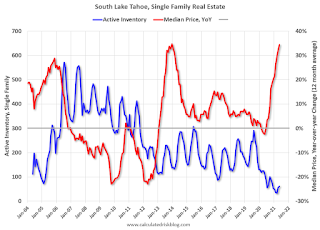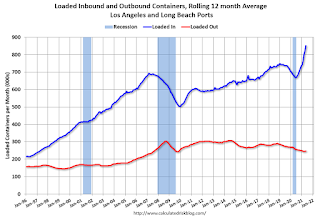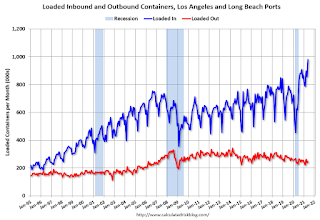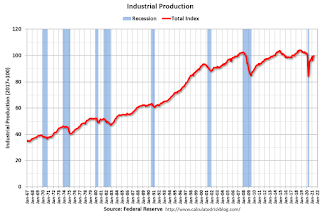by Calculated Risk on 6/15/2021 08:48:00 PM
Tuesday, June 15, 2021
Wednesday: Housing Starts, FOMC Statement
Wednesday:
• At 7:00 AM ET, The Mortgage Bankers Association (MBA) will release the results for the mortgage purchase applications index.
• At 8:30 AM, Housing Starts for May. The consensus is for 1.630 million SAAR, up from 1.569 million SAAR in April.
• At 2:00 PM, FOMC Meeting Announcement. No change to policy is expected at this meeting.
• At 2:00 PM, FOMC Forecasts This will include the Federal Open Market Committee (FOMC) participants' projections of the appropriate target federal funds rate along with the quarterly economic projections.
• At 2:30 PM, Fed Chair Jerome Powell holds a press briefing following the FOMC announcement.
Second Home Market: South Lake Tahoe in May
by Calculated Risk on 6/15/2021 03:59:00 PM
Three months ago, from Jann Swanson at MortgageNewsDaily: Fannie Warns Lenders on Investment Properties and 2nd Homes. This action will result in higher interest rates on 2nd home and investment property mortgages.
I'm looking at data for some second home markets - and will track those markets to see if there is an impact from the lending changes.
This graph is for South Lake Tahoe since 2004 through May 2021, and shows inventory (blue), and the year-over-year (YoY) change in the median price (12 month average).
Note: The median price is distorted by the mix, but this is the available data.

Following the housing bubble, prices declined for several years in South Lake Tahoe, with the median price falling about 50% from the bubble peak.
Note that inventory was high while prices were declining - and significantly lower inventory in 2012 suggested the bust was over. (Tracking inventory helped me call the bottom for housing way back in February 2012, see:The Housing Bottom is Here)
Currently inventory is just above the record low set two months ago, and prices are up sharply YoY. This will be interesting to watch.
June 15th COVID-19 New Cases, Vaccinations, Hospitalizations
by Calculated Risk on 6/15/2021 03:42:00 PM
This data is from the CDC.
According to the CDC, on Vaccinations.
Total doses administered: 311,886,674, as of yesterday 310,645,827. Daily: 1.24 million.
| COVID Metrics | |||
|---|---|---|---|
| Current | Yesterday | Goal | |
| Percent over 18, One Dose | 64.6% | 64.5% | ≥70.0%1,2 |
| Fully Vaccinated (millions) | 145.8 | 144.9 | ≥1601 |
| New Cases per Day3 | 12,415 | 12,676 | ≤5,0002 |
| Hospitalized3 | 14,232 | 13,944 | ≤3,0002 |
| Deaths per Day3 | 292 | 325 | ≤502 |
| 1 America's Goal by July 4th, 2my goals to stop daily posts, 37 day average for Cases, Hospitalized, and Deaths | |||
KUDOS to the residents of the 14 states and D.C. that have already achieved the 70% goal: Vermont, Hawaii and Massachusetts are at 80%+, and Connecticut, New Jersey, Maine, Rhode Island, Pennsylvania, New Mexico, California, New Hampshire, Maryland, Washington, New York and D.C. are all over 70%.
Next up are Illinois at 69.7%, Virginia at 69.3%, Minnesota at 68.7%, Delaware at 68.4%, Colorado at 68.0%, Oregon at 68.0% and Wisconsin at 64.2%.
 Click on graph for larger image.
Click on graph for larger image.This graph shows the daily (columns) and 7 day average (line) of positive tests reported.
This data is from the CDC.
LA Area Port Traffic: Record Imports in May
by Calculated Risk on 6/15/2021 02:26:00 PM
Note: The expansion to the Panama Canal was completed in 2016 (As I noted a few years ago), and some of the traffic that used the ports of Los Angeles and Long Beach is probably going through the canal. This might be impacting TEUs on the West Coast.
Container traffic gives us an idea about the volume of goods being exported and imported - and usually some hints about the trade report since LA area ports handle about 40% of the nation's container port traffic.
The following graphs are for inbound and outbound traffic at the ports of Los Angeles and Long Beach in TEUs (TEUs: 20-foot equivalent units or 20-foot-long cargo container).
To remove the strong seasonal component for inbound traffic, the first graph shows the rolling 12 month average.

On a rolling 12 month basis, inbound traffic was up 3.7% in May compared to the rolling 12 months ending in April. Outbound traffic was up 0.2% compared to the rolling 12 months ending the previous month.
The 2nd graph is the monthly data (with a strong seasonal pattern for imports).

Imports were up 58% YoY in May (collapsed last year due to pandemic), and exports were up 2.6% YoY.
NAHB: Builder Confidence Declined to 81 in May
by Calculated Risk on 6/15/2021 10:09:00 AM
The National Association of Home Builders (NAHB) reported the housing market index (HMI) was at 81, down from 83 in April. Any number above 50 indicates that more builders view sales conditions as good than poor.
From the NAHB: Rising Material Challenges, Declining Builder Sentiment
Rising material prices and supply chain shortages resulted in builder confidence dipping to its lowest level since August 2020. The latest National Association of Home Builders (NAHB)/Wells Fargo Housing Market Index (HMI) released today shows that builder confidence in the market for newly built single-family homes fell two points to 81 in June. Despite the monthly decline, the reading above 80 is still a signal of strong demand in a housing market lacking inventory.
“Higher costs and declining availability for softwood lumber and other building materials pushed down builder sentiment in June,” said NAHB Chairman Chuck Fowke. “These higher costs have moved some new homes beyond the budget of prospective buyers, which has slowed the strong pace of home building. Policymakers need to focus on supply-chain issues in order to allow the economic recovery to continue.”
“While builders have adopted a variety of business strategies including price escalation clauses to deal with scarce building materials, labor and lots, unavoidable increases for new home prices are pushing some buyers to the sidelines,” said NAHB Chief Economist Robert Dietz. “Moreover, these supply-constraints are resulting in insufficient appraisals and making it more difficult for builders to access construction loans.”
...
All three of the major HMI indices posted declines in June: current sales conditions fell two points to 86; sales expectations in the next six months posted a two-point decline to 79; and traffic of prospective buyers dropped two points to 71.
Looking at the three-month moving averages for regional HMI scores: the South rose one point to 85; the West fell one point to 89; the Midwest dropped three points to 72; and the Northeast posted a five-point decline to 78.
 Click on graph for larger image.
Click on graph for larger image.This graph show the NAHB index since Jan 1985.
This was below the consensus forecast, but still a very strong reading - and lumber prices have fallen sharply recently.
Industrial Production Increased 0.8 Percent in May
by Calculated Risk on 6/15/2021 09:32:00 AM
From the Fed: Industrial Production and Capacity Utilization
Total industrial production increased 0.8 percent in May. Manufacturing production advanced 0.9 percent, reflecting, in part, a large gain in motor vehicle assemblies; factory output excluding motor vehicles and parts increased 0.5 percent. The indexes for mining and utilities rose 1.2 percent and 0.2 percent, respectively.
In May, at 99.9 percent of its 2017 average, total industrial production was 16.3 percent higher than it was a year earlier but 1.4 percent lower than its pre-pandemic (February 2020) level. Capacity utilization for the industrial sector rose 0.6 percentage point in May to 75.2 percent, a rate that is 4.4 percentage points below its long-run (1972–2020) average.
emphasis added
 Click on graph for larger image.
Click on graph for larger image.This graph shows Capacity Utilization. This series is up from the record low set in April, but still below the level in February 2020.
Capacity utilization at 75.2% is 4.4% below the average from 1972 to 2020.
Note: y-axis doesn't start at zero to better show the change.
 The second graph shows industrial production since 1967.
The second graph shows industrial production since 1967.Industrial production increased in May to 106.3. This is 1.4% below the February 2020 level.
The change in industrial production was below consensus expectations.
Retail Sales Decreased 1.3% in May
by Calculated Risk on 6/15/2021 08:44:00 AM
On a monthly basis, retail sales were decreased 1.3% from April to May (seasonally adjusted), and sales were up 28.1 percent from May 2020.
From the Census Bureau report:
Advance estimates of U.S. retail and food services sales for May 2021, adjusted for seasonal variation and holiday and trading-day differences, but not for price changes, were $620.2 billion, a decrease of 1.3% from the previous month, but 28.1 percent above May 2020. ... The March 2021 to April 2021 percent change was revised from virtually unchanged to up 0.9 percent.
emphasis added
 Click on graph for larger image.
Click on graph for larger image.This graph shows retail sales since 1992. This is monthly retail sales and food service, seasonally adjusted (total and ex-gasoline).
Retail sales ex-gasoline were down 1.5% in May.
The second graph shows the year-over-year change in retail sales and food service (ex-gasoline) since 1993.
 Retail and Food service sales, ex-gasoline, increased by 26.1% on a YoY basis.
Retail and Food service sales, ex-gasoline, increased by 26.1% on a YoY basis.Sales in May were below expectations, however sales in March and April were revised up.
Monday, June 14, 2021
Tuesday: Retail Sales, PPI, NY Fed Mfg, Industrial Production, Homebuilder Confidence
by Calculated Risk on 6/14/2021 09:00:00 PM
From Matthew Graham at Mortgage News Daily: MBS RECAP: New Week, New Sense of Urgency
The new week wasted no time in differentiating itself from the previous week as bonds sold off somewhat briskly this morning. ... The bigger question of "where do we go from here" may depend on the incoming data and especially Wednesday afternoon's Fed announcement/forecasts. Despite the early selling pressure, bonds offered some reassurance in the afternoon by holding calmly under 1.50%. [30 year fixed 3.05%]Tuesday:
emphasis added
• At 8:30 AM ET, Retail sales for May is scheduled to be released. The consensus is for 0.4% decrease in retail sales.
• Also at 8:30 AM, The Producer Price Index for May from the BLS. The consensus is for a 0.6% increase in PPI, and a 0.6% increase in core PPI.
• Also at 8:30 AM, The New York Fed Empire State manufacturing survey for June. The consensus is for a reading of 22.0, down from 24.3.
• At 9:15 AM, The Fed will release Industrial Production and Capacity Utilization for May. The consensus is for a 0.6% increase in Industrial Production, and for Capacity Utilization to increase to 75.1%.
• At 10:00 AM, The June NAHB homebuilder survey. The consensus is for a reading of 83, unchanged from 83 last month. Any number below 50 indicates that more builders view sales conditions as poor than good.
Mortgage Equity Withdrawal in Q1 2021
by Calculated Risk on 6/14/2021 04:31:00 PM
Note: This is not Mortgage Equity Withdrawal (MEW) data from the Fed. The last MEW data from Fed economist Dr. Kennedy was for Q4 2008.
The following data is calculated from the Fed's Flow of Funds data (released last week) and the BEA supplement data on single family structure investment. This is an aggregate number, and is a combination of homeowners extracting equity - hence the name "MEW" - and normal principal payments and debt cancellation (modifications, short sales, and foreclosures).
For Q1 2021, the Net Equity Extraction was $41 billion, or 0.8% of Disposable Personal Income (DPI) . This is nothing like the amount of equity extraction during the housing bubble as a percent of DPI.

This graph shows the net equity extraction, or mortgage equity withdrawal (MEW), results, using the Flow of Funds (and BEA data) compared to the Kennedy-Greenspan method.
MEW has been mostly positive for the last five years.
The Fed's Flow of Funds report showed that the amount of mortgage debt outstanding increased by $117 billion in Q1.
For reference:
Dr. James Kennedy also has a simple method for calculating equity extraction: "A Simple Method for Estimating Gross Equity Extracted from Housing Wealth". Here is a companion spread sheet (the above uses my simple method).
For those interested in the last Kennedy data included in the graph, the spreadsheet from the Fed is available here.
MBA Survey: "Share of Mortgage Loans in Forbearance Decreases to 4.04%"
by Calculated Risk on 6/14/2021 04:00:00 PM
Note: This is as of June 6th.
From the MBA: Share of Mortgage Loans in Forbearance Decreases to 4.04%
The Mortgage Bankers Association’s (MBA) latest Forbearance and Call Volume Survey revealed that the total number of loans now in forbearance decreased by 12 basis points from 4.16% of servicers’ portfolio volume in the prior week to 4.04% as of June 6, 2021. According to MBA’s estimate, 2 million homeowners are in forbearance plans.
The share of Fannie Mae and Freddie Mac loans in forbearance decreased 9 basis points to 2.09%. Ginnie Mae loans in forbearance decreased 32 basis points to 5.22%, while the forbearance share for portfolio loans and private-label securities (PLS) increased 2 basis points to 8.33%. The percentage of loans in forbearance for independent mortgage bank (IMB) servicers decreased 13 basis points to 4.21%, and the percentage of loans in forbearance for depository servicers decreased 14 basis points to 4.19%.
“MBA estimates that 2 million homeowners remain in forbearance as of June 6th. The share of loans in forbearance has now declined for 15 straight weeks, with a larger decline this week as many reached the 15-month mark,” said Mike Fratantoni, MBA’s Senior Vice President and Chief Economist. “Forbearance exits increased – as is typical in the beginning of a month – and reached the fastest pace since April. New forbearance requests, at 4 basis points, remained at an extremely low level.”
Added Fratantoni, “We are seeing an increase in the share of forbearance exits, where borrowers do not have a loss mitigation plan in place. Homeowners who are reaching the end of their forbearance term need to contact their servicer to discuss the next steps in the process, as servicers cannot extend the forbearance term without talking to the borrower.”
emphasis added
 Click on graph for larger image.
Click on graph for larger image.This graph shows the percent of portfolio in forbearance by investor type over time. Most of the increase was in late March and early April 2020, and has trended down since then.
The MBA notes: "Total weekly forbearance requests as a percent of servicing portfolio volume (#) remained the same relative to the prior week at 0.04%."


